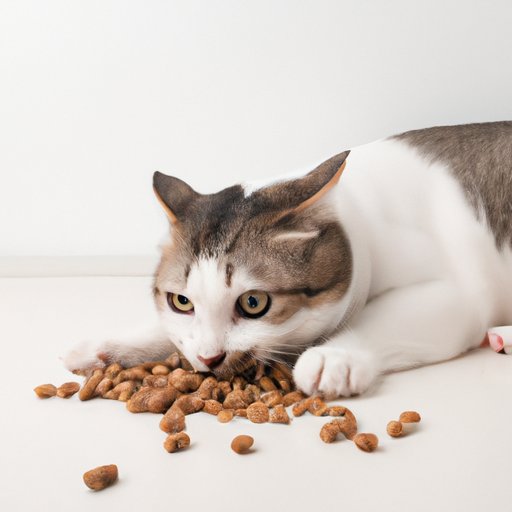
Introduction
If you have an underweight cat, you know how concerning it can be. Your cat may seem lethargic, weak, or just not themselves. There can be many reasons why a cat may be underweight, from dental problems to underlying health issues. Whatever the cause, it’s essential to address the situation to ensure your cat’s overall well-being and health.
In this article, we’ll provide you with practical solutions and tips for helping your cat gain weight. We’ll discuss the importance of nutrient-rich, high-calorie food, frequent feedings, elevated food bowls, wet food, and treats and supplements as potential strategies for helping an underweight cat. By the end of this article, you’ll be better equipped to help your cat achieve a healthy weight and regain their energy and vitality.
Nutrient-rich, high-calorie food
Feeding your cat high-quality, nutrient-rich food is essential for overall health, and it’s especially critical when a cat is underweight. Cats who are underweight typically need more calories to gain weight than their standard feeding schedule provides.
When choosing food for your cat, it’s crucial to select options specifically formulated for their needs. There are many high-calorie cat foods on the market, but not all of them are created equal. Look for foods that contain high-quality protein sources, healthy fats, and complex carbohydrates. Some examples of high-calorie cat foods include Royal Canin Veterinary Diet Gastrointestinal High Energy, Hill’s Prescription Diet a/d Urgent Care, and Purina Pro Plan Veterinary Diets NF Kidney Function.
It’s important to note that you should always consult with your veterinarian before altering your cat’s diet. They can help you identify appropriate food options based on your cat’s age, health history, and nutritional needs.
Frequent feedings
Offering multiple, smaller meals throughout the day can help increase a cat’s caloric intake. This approach is especially helpful for underweight cats who may not eat large amounts in one sitting. Try setting feeding times throughout the day, such as three to five times daily, and providing smaller portion sizes.
You can also use puzzle feeders or food-dispensing toys to encourage your cat to eat. When your cat has to “work” for their food, they may be inclined to eat more overall. Additionally, interactive feeders can provide enrichment for your cat and keep them mentally stimulated.
Elevated food bowls
If your cat has trouble eating from ground-level bowls, elevated food bowls can be a helpful solution. Elevated bowls can improve posture and decrease strain on your cat’s neck while eating. Additionally, they can reduce the risk of digestive issues that may arise from eating from ground-level bowls, such as regurgitation or bloating.
When choosing an elevated food bowl, consider the height and design. You want to select a bowl that provides a comfortable feeding position for your cat, without being too high or too low. Some examples of elevated food bowls include the PetFusion Elevated Cat Feeder, Necoichi Raised Cat Food Bowl, and MyGift Deluxe Wrought Iron Elevated Cat Feeder.
Wet food
Wet food can be an excellent option for underweight cats, as it typically contains higher moisture content and more palatable for picky eaters. Additionally, it can provide an additional source of hydration, which can be especially helpful for cats who may not drink enough water independently.
You can introduce wet food into your cat’s diet by gradually mixing increasing amounts of wet food into their current diet, until they are consuming only wet food. Look for high-quality canned wet food that contains high moisture content, low carbohydrates, and high protein levels, such as Blue Buffalo Wilderness Chicken Grain-Free Canned Cat Food, Merrick Purrfect Bistro Grain-Free Healthy Adult Chicken Recipe, or Wellness Complete Health Pâté Chicken Entree.
Treats and supplements
Treats and supplements can be a useful tool in helping an underweight cat gain weight and address any nutritional deficiencies. When selecting treats, look for calorie-dense options that contain high-quality protein sources, healthy fats, and complex carbohydrates.
Supplements can also be valuable in providing additional nutrients that a cat may not be receiving from their standard diet. However, it’s essential to consult with your veterinarian before introducing any new supplements or treats, as they can provide guidance on appropriate dosages and possible interactions with your cat’s current medication.
Conclusion
If your cat is underweight, there are many steps you can take to help them achieve a healthy weight and regain their energy. Feeding your cat nutrient-rich, high-calorie food, offering frequent feedings, using elevated food bowls, incorporating wet food into their diet and offering calorie-dense treats, and supplements are all viable options. Above all else, it’s essential to consult with your veterinarian to develop an appropriate weight-gain plan that takes into account your cat’s unique needs and health status. With a bit of patience and persistence, you can restore your cat to their healthy and happy self.




